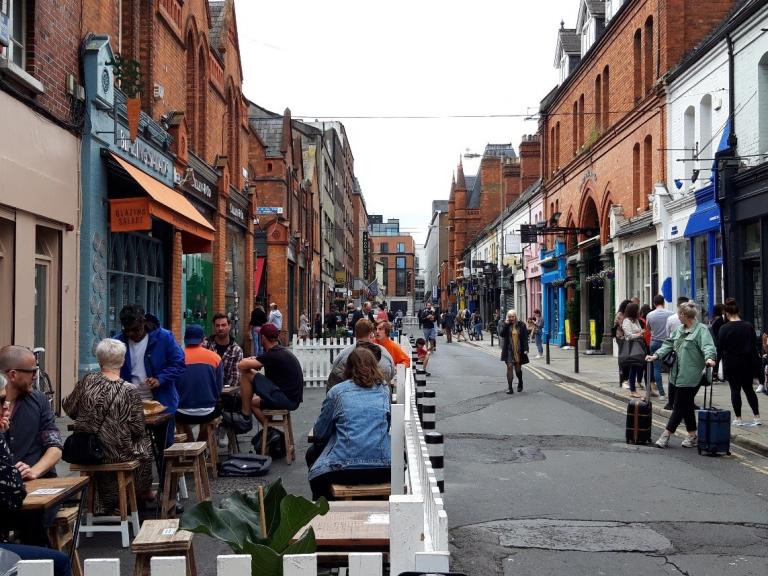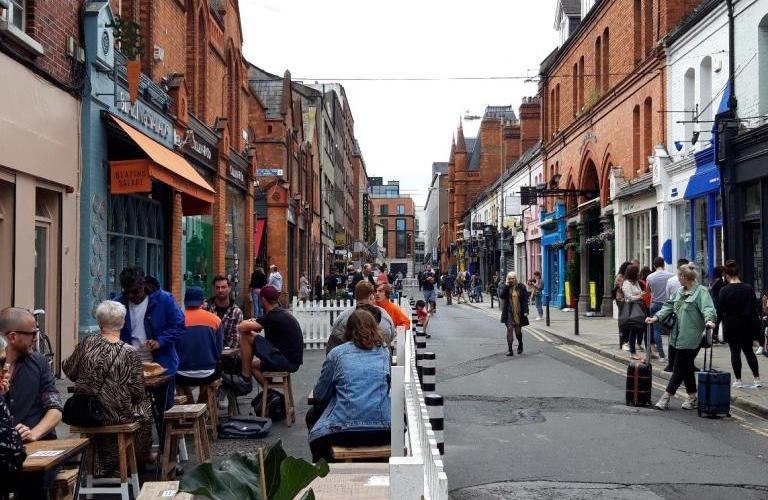Drivers parallel parking causes others to swerve into oncoming traffic. Cyclists weave between delivery trucks and rideshare vehicles. Buses collect passengers as fire trucks pull out of the station, lights on, sirens wailing. Add shoppers, dog walkers and children to the mix and Centre Street in Jamaica Plain can be chaotic, even during a shutdown.
But renewed discussions about making the major thoroughfare more pedestrian-friendly, in neighborhood council meetings and local online discussion boards, are more than appeals for calm and less congestion.
They are about helping local businesses survive COVID-19.
Pilot pedestrianization programs in the U.S. and Europe might provide a blueprint for what cutting traffic to Centre Street might look like, and if such a measure would actually help businesses, while Jamaica Plain locals have reimagined the corridor along Centre Street and South Street many times over the years.
The most dramatic option tabled has been to close the road off to all traffic.
“We’ve floated this idea a few times,” said Ginger Brown, executive director for JP Centre/South Main Streets, in an email. But, she said, the proposal has always seemed “difficult.”
“It’s important to keep in mind that the buses that go through Centre and South Street are a lifeline for many in our community and their unimpeded routes are extremely important,” said Brown. She also noted that the only other parallel two-way street in the area is the the Arborway, along which buses are not permitted.
The 39 and 41 buses run along Centre Street and provide important access for residents in Forrest Hills and beyond to the city center.
“It would be virtually impossible to shut down Centre Street to traffic due to the major bus routes that use it,” said Audrey White, owner of Carrot Flower, a plant-based cafe on Centre Street, in an email. She said the idea hasn’t been discussed at recent Jamaica Plain Business and Professional Association meetings, but that she would be open to reviewing specific plans to pedestrianize the area if any were brought forward.
Then there are the emergency vehicles that rely on Centre Street for direct access through Jamaica Plain to nearby medical facilities, including Lemuel Shattuck Hospital and the Hebrew Rehabilitation Center, as well as Engine 28 Ladder 10 fire station at 746 Centre Street.
For the numerous ambulances, fire engines and police cars passing along Centre Street daily “there are no adequate alternative routes,” said Brown. “The other one-way and circuitous streets of JP would be a major impediment to their operation.”
Rerouting regular traffic is also another hurdle regularly cited. Pushing cars onto the narrow, one-way streets that surround Centre and South Street may only cause further congestion and chaos.
But in other cities, not too far from home, officials have found solutions and made pedestrian commercial districts work during the pandemic.
Waltham’s Traffic Commission has approved the temporary closure of Moody Street and the area will remain pedestrianized until November 1, while in Portland, Maine, a pilot program to close several streets started June 1 and the space is now being used by an open-air market, local restaurants and stores.
It’s unclear if organizers of these pilot programs dealt with the same issues — public transport routes and emergency vehicle access — as those of in JP would face. And it may even be too early to tell how successful these programs are.
But early data from a trial in Dublin, Ireland, show positive results for local businesses.
In the city’s busy Grafton Street area sections were closed to all vehicles between 11 a.m. and 11 p.m. on weekends and during bank holidays. A survey of 292 businesses from the experiment’s first weekend showed owners enjoyed increased takings of between 40% and 100%.

This trend will hopefully continue over the coming weekends, but some business owners are skeptical that such a plan would benefit Jamaica Plain’s businesses.
“I don’t think it would necessarily bring more business to the district, at least not enough to warrant the major disruption,” said White.
If a complete closure is untenable, then an alternative solution could be to remove parking spaces to accommodate more outside dining and retail.
“I am in favor of widening sidewalks, and having temporary pedestrian lanes in lieu of parallel parking while we weather this pandemic,” said Brown.
“Sidewalk seating is usually easier in Jamaica Plain using parking spaces rather than sidewalk space,” wrote Michael Reiskind in the Jamaica Plain Neighborhood Council June meeting minutes. “It’s a question residents have long been asking, and it’s come up again as businesses are starting to slowly reopen after the COVID-19 shutdown.”
But there are concerns about removing parking spaces, particularly from disability advocates. Reducing parking may make an area more inaccessible for those who cannot take public transport, need their cars to travel safely or who must park directly outside their destination.
In the Dublin trial disabled parking spaces were relocated nearby to accommodate the closures.
Removing parking, while still allowing access for public transport and emergency vehicles, is a feasible solution that could help businesses recover from the financial damage wrought by COVID-19, said Brown.
“This can be done without changing the bus routes or the flow of traffic on Centre and South Street,” said Brown. “It requires giving up some parking but I think that’s a sacrifice that we can easily make.”
